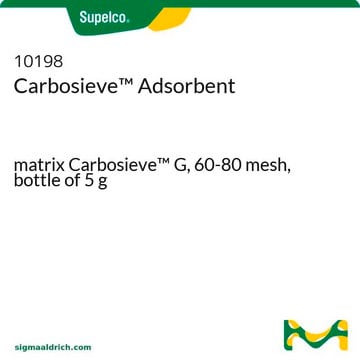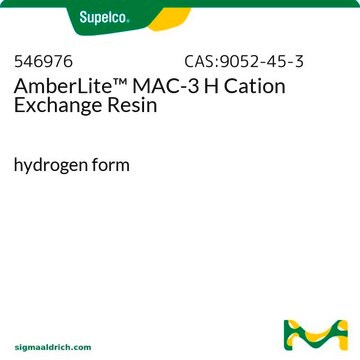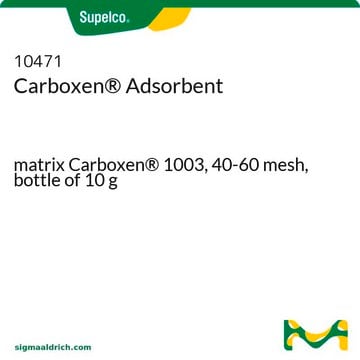10199
Carbosieve Carbon Adsorbent
matrix Carbosieve G, 80-100 mesh, bottle of 5 g
About This Item
Recommended Products
product name
Carbosieve Adsorbent, matrix Carbosieve G, 80-100 mesh, bottle of 5 g
product line
Carbosieve
form
powder or granules
packaging
bottle of 5 g
technique(s)
LPLC: suitable
gas chromatography (GC): suitable
solid phase extraction (SPE): suitable
surface area
~1160 m2/g
matrix
Carbosieve G
matrix active group
carbon
particle size
80-100 mesh
pore size
~0.02 cm3/g mesoporosity
~0.49 cm3/g microporosity
~0 cm3/g macroporosity
~6-15 Å pore diameter
density
~0.27 g/mL (free fall density)
separation technique
reversed phase
Looking for similar products? Visit Product Comparison Guide
General description
- Spherical (better packed bed performance than granular particles)
- Hard and non-friable (pack well, will not break)
- Highly porous (high surface areas)
- Used for molecules with an analyte size relative to C2-C5 n-alkanes
- Hydrophobic (can be used in high humidity environments)
Generally, CMS adsorbents offer greater relative adsorptive strength compared to spherical graphitized polymer carbon (SGPC) and graphitized carbon black (GCB) adsorbents. Our Carbosieve products are a type of CMS adsorbent.
- Have non-tapered pores
- Very strong adsorptive strength due to only containing micropores
- Provide great performance for many small, volatile analytes that most adsorbents have trouble retaining
For more information about any of our specialty carbon adsorbents, please visit sigma-aldrich.com/carbon
Legal Information
Storage Class Code
11 - Combustible Solids
WGK
nwg
Flash Point(F)
Not applicable
Flash Point(C)
Not applicable
Personal Protective Equipment
Choose from one of the most recent versions:
Certificates of Analysis (COA)
Sorry, we don't have COAs for this product available online at this time.
If you need assistance, please contact Customer Support.
Already Own This Product?
Find documentation for the products that you have recently purchased in the Document Library.
Our team of scientists has experience in all areas of research including Life Science, Material Science, Chemical Synthesis, Chromatography, Analytical and many others.
Contact Technical Service






